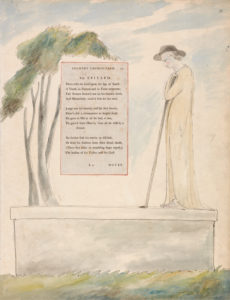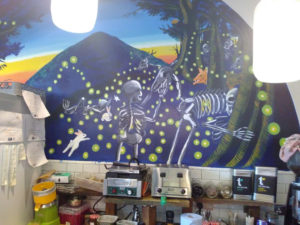Dr Ellen Pilsworth reports on the symposium Death and Dying in the Long Eighteenth Century held at IMLR, Senate House, London in September 2018
On 25 September 2018, researchers of eighteenth-century literature and culture gathered from around the world at the Institute of Modern Languages Research in Senate House, London, to discuss how death and dying were conceptualised, represented, and greeted in their period of study. In her opening remarks, organiser Dr Ellen Pilsworth discussed the differences of mindset around death and dying in this period – citing not only the religious frameworks within which it was often (though not always) conceived, but also the far higher mortality rates in this period, particularly for children under five. While death and mourning were seen in the eighteenth-century as a normal part of life, in our own contemporary culture death has now become a ‘taboo subject,’ as Geoffrey Gorer remarked in Death, Grief and Mourning in Contemporary Britain (1965). A study of approaches to death and dying in the eighteenth century can show us, therefore, which ideas and practices we have lost since then, as well as which fears and anxieties have remained with us despite medical and social developments.
 James Metcalf kicked off the first panel exploring approaches to death in eighteenth-century literature with his paper on ‘The Eighteenth-Century Churchyard as a Contemplative Landscape.’ Through a reading of texts produced for and inspired by the graveyard, Metcalf demonstrated the significant cultural importance of graveyards as places for the dead to communicate with the living, and for the living to contemplate the space between being and non-being. Phoebus Cotsapas followed this with his consideration of Diderot’s philosophy of death from a materialist perspective, seeing all life as being made up of matter that lives on beyond our own lifespan, before Joanna Raisbeck built on this by showing Günderrode’s own reflections on mortality within the framework of Spinozism.
James Metcalf kicked off the first panel exploring approaches to death in eighteenth-century literature with his paper on ‘The Eighteenth-Century Churchyard as a Contemplative Landscape.’ Through a reading of texts produced for and inspired by the graveyard, Metcalf demonstrated the significant cultural importance of graveyards as places for the dead to communicate with the living, and for the living to contemplate the space between being and non-being. Phoebus Cotsapas followed this with his consideration of Diderot’s philosophy of death from a materialist perspective, seeing all life as being made up of matter that lives on beyond our own lifespan, before Joanna Raisbeck built on this by showing Günderrode’s own reflections on mortality within the framework of Spinozism.
After a break for lunch, we divided into two panels. One focused on German literature, with three papers by researchers Dr Dagmar Paulus (on death as atonement in the German Schisalsdrama), Dr Philipp Ritzen (on death and dying in Heine’s Romanzero), and Dr Kristin Eichhorn (on joi de vivre in Gellert’s novel, Leben der schwedischen Gräfin von G***). The other panel featured two papers concerned with the grey area between death and life, both as a medical problem (‘apparent death,’ explored by Dr Simon Aeberhard) and as an effect of highly realistic painting in the work of John Singleton Copley, explored by Caroline Culp.
The final panel explored eighteenth-century institutional approaches to death, within the framework of job applications and funeral sermons (highlighted by Stephan Strunz) and with reference to the Christian teachings on hell and damnation (analysed by Professor Ritchie Robertson).
 After closing remarks from the organiser, participants retired for a quick half pint before joining with members of the public in Moreish Café Deli for an official Death Café, facilitated by Ellen Pilsworth. Death Cafés are occasions for people to discuss death and dying in an open manner, over tea and cake. (For more information, see here.) The café was packed, and thanks to the generosity of café owner Jenny Stern, still serving delicious food. The café’s mural served as the perfect backdrop for our challenging but fascinating discussions of how we would like to die, how we would like to be remembered, and how others we know have coped with death and loss. Participants from the death café rated it 5/5 and described it as ‘thought-provoking,’ ‘enlightening’ and ‘memorable.’
After closing remarks from the organiser, participants retired for a quick half pint before joining with members of the public in Moreish Café Deli for an official Death Café, facilitated by Ellen Pilsworth. Death Cafés are occasions for people to discuss death and dying in an open manner, over tea and cake. (For more information, see here.) The café was packed, and thanks to the generosity of café owner Jenny Stern, still serving delicious food. The café’s mural served as the perfect backdrop for our challenging but fascinating discussions of how we would like to die, how we would like to be remembered, and how others we know have coped with death and loss. Participants from the death café rated it 5/5 and described it as ‘thought-provoking,’ ‘enlightening’ and ‘memorable.’
Many thanks go to the Institute of Modern Languages Research and the Sylvia Naish Fund, which made this workshop possible, and to Jenny Stern for allowing us to hold the death café in such a warm and welcoming space.
Dr Ellen Pilsworth is a lecturer in German and Translation Studies at the University of Reading, where she teaches on German literature and culture from the eighteenth century to the present day, as well as leading seminars in translation from German to English. Aside from approaches to death and dying, her research also investigates the intersections between literature and politics from the eighteenth century to the present day.
